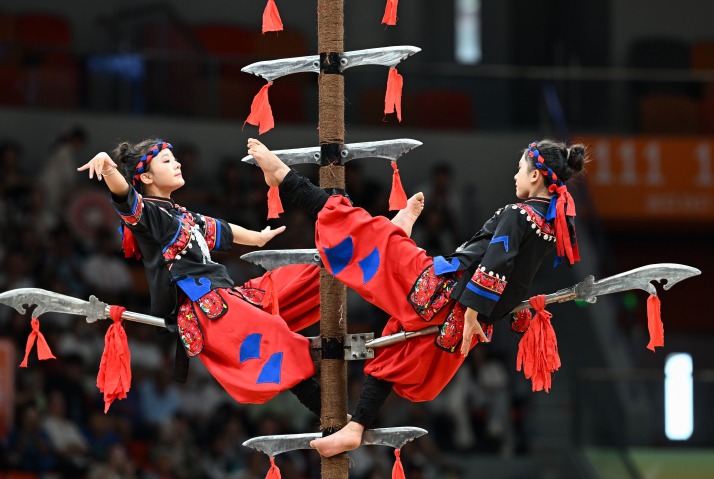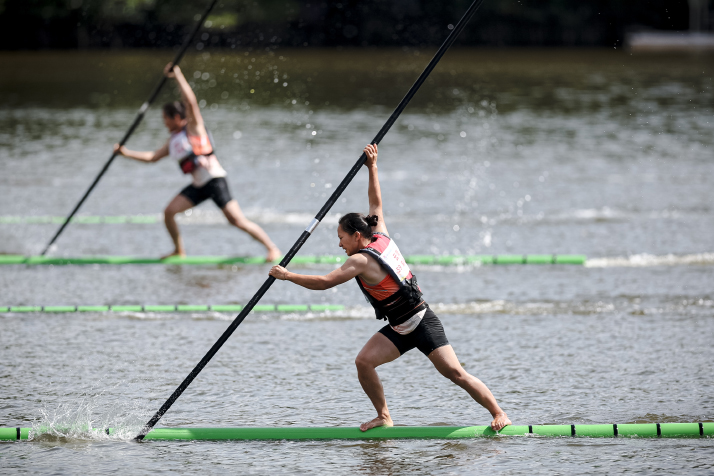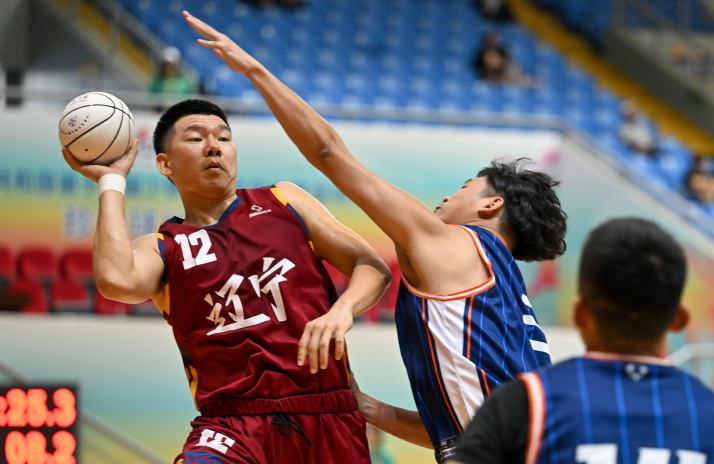| China |
| China's ethnic cultures shine at national games | |
|
|
 A Flying Dragon Sword performance by the Guizhou Province team during the 12th National Traditional Games of Ethnic Minorities in Sanya, Hainan Province, on November 23 (XINHUA)
Zhu Mengdan, a 15-year-old from the Li ethnic group, grew up climbing betel nut trees and coconut palms. However, she had never imagined that the games she played with her friends would one day evolve into an official event at a national sporting competition. The coconut palm climbing race, a newly introduced event at this year's National Traditional Games of Ethnic Minorities, originates from the traditional practices of local ethnic communities, particularly the Li and Miao ethnic groups of China's southernmost island province of Hainan, who climb the palms to harvest coconuts. Zhu, the youngest competitor on Hainan's team this year, competed in the coconut palm climbing race, which featured 11 teams comprising 33 men and 26 women from different sectors of society. She said the event is a showcase of Hainan's unique cultural identity. "I hope this event continues to grow," she remarked. Now in their 12th year, the Games, held in Sanya, Hainan, from November 22 to 30, promote harmony and cultural integration among China's 56 ethnic groups. The Games provide a platform for athletes to compete, share their cultures and celebrate their diverse heritage and skills. Diversity and unity China, a multiethnic country with a population of 1.4 billion, is home to 56 ethnic groups. The Han, who constitute about 91 percent of the population, form the majority, while the remaining 55 groups, collectively referred to as ethnic minorities, enrich the country's cultural diversity. According to the 2020 national census, the populations of these ethnic minority groups range from 19.6 million for the Zhuang, the largest minority, to just 3,544 for the Tatar, the smallest. The Zhuang mainly reside in Guangxi Zhuang Autonomous Region, south China, whereas the Tatar are concentrated in Xinjiang Uygur Autonomous Region in northwest China. The ethnic groups were officially identified based on extensive field research after the founding of the People's Republic of China in 1949. The National Traditional Games of Ethnic Minorities first took place in 1953 in Tianjin, where nearly 400 athletes representing 13 ethnic groups competed. After a hiatus of nearly 30 years, the second edition of the event was held in Hohhot, Inner Mongolia Autonomous Region, in 1982 Zhang Huaichuan, a track and field coach at Beijing Sport University, attended the Games for the third time with his students this year. "Many of the athletes have graduated from the university and entered their professional careers, returning to their hometowns or settling down in other ethnic regions. They are now involved in education, helping promote ethnic sports within their communities," he told Xinhua News Agency, highlighting the event's importance.  Athletes participate in a single-bamboo drifting race on November 27 (XINHUA)
The joys of competing Nearly 7,000 athletes from 35 delegations from across China participated in the nine-day event, in 18 competitive sports and three demonstration sports. The Games feature competitions rooted in the traditional customs of China's ethnic minorities, blending elements of entertainment and athelticism. Take the coconut palm climbing race as an example. Athletes must ascend either a natural coconut palm, or an artificial palm that is 9 meters tall for men or 7 meters for women. They can use their preferred climbing techniques but must reach the top to ring a bell. The winner is determined by the fastest time. Another event, single-bamboo drifting, involves participants standing barefoot on a single bamboo pole (or a similar floating structure) and using a paddle to propel themselves forward. The competition measures speed, with the winner completing the designated distance in the shortest time. From a distance, the performance resembles running on water. This traditional skill originates in the northern region of Guizhou Province, specifically along the Chishui River. It was initially a practical method of water transportation for locals, especially the Miao people. Over time, it evolved into a recreational and competitive sport with a history spanning over 2,000 years. In 2021, Chishui single-bamboo drifting was recognized as national intangible cultural heritage. Pearl ball, another traditional sport, traces its roots to the Manchu folk game known as "pearl harvesting." This game mimics the work of pearl divers in northeast China, who either placed collected clams into baskets or tossed them from boats onto the shore, relying on precision to maximize efficiency.  A pearl ball match underway on November 24 (XINHUA)
Over time, pearl harvesting developed into a competitive team sport. Players pass a "pearl"—a small, often white, ball—through a hoop on a court the size of a basketball court. The game features four zones: the water zone (main play area), the scoring zone, the restricted zone and the blocking zone. Each team consists of seven players, with four operating in the water zone to pass, dribble and shoot the ball toward the scoring zone. In pearl ball, the "hoop" is actually a teammate holding a net bag. Positioned in the scoring zone, this player can move and jump to catch incoming shots. Points are scored when a player successfully throws the ball into the net. "Pearl ball's unique format allows players to leverage their strengths, making it accessible and exciting for all participants," Li Chao, a veteran pearl ball player from Liaoning Province who has competed in five editions of the Games, told Xinhua. Li underscored the sport's growing popularity, which has extended well beyond its Manchu origins to gain nationwide traction. In 2008, pearl ball was included in the national intangible cultural heritage list. A special gala was also held during the Games to celebrate the rich diversity of China's ethnic groups. Athletes and guests were treated to energetic performances of traditional songs and dances, theatrical presentations, demonstration of other folk customs, and exhibitions showcasing Hainan's intangible cultural heritage. Interactive activities, including a parade, added to the lively atmosphere. "I hope to promote our ethnic culture and traditional sports so that more people can understand and appreciate them," Luo Jun, a coconut palm climbing race athlete and firefighter from the Hainan team, said in an interview with news portal Qianlong.com. Copyedited by Elsbeth van Paridon Comments to luyan@cicgamericas.com |
|
||
|
||||||||||||||||||||||||||||
|